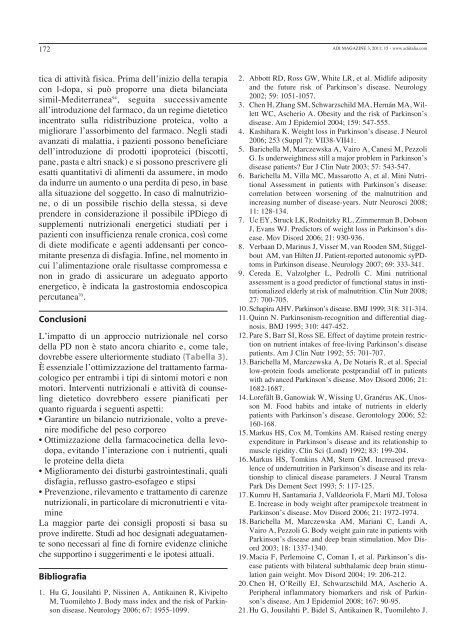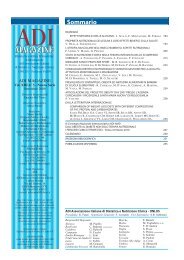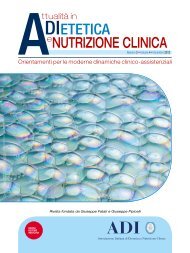nasce la sensibilità al glutine - Adi
nasce la sensibilità al glutine - Adi
nasce la sensibilità al glutine - Adi
You also want an ePaper? Increase the reach of your titles
YUMPU automatically turns print PDFs into web optimized ePapers that Google loves.
172<br />
tica di attività fisica. Prima dell’inizio del<strong>la</strong> terapia<br />
con l-dopa, si può proporre una dieta bi<strong>la</strong>nciata<br />
simil-Mediterranea 94 , seguita successivamente<br />
<strong>al</strong>l’introduzione del farmaco, da un regime dietetico<br />
incentrato sul<strong>la</strong> ridistribuzione proteica, volto a<br />
migliorare l’assorbimento del farmaco. Negli stadi<br />
avanzati di ma<strong>la</strong>ttia, i pazienti possono beneficiare<br />
dell’introduzione di prodotti ipoproteici (biscotti,<br />
pane, pasta e <strong>al</strong>tri snack) e si possono prescrivere gli<br />
esatti quantitativi di <strong>al</strong>imenti da assumere, in modo<br />
da indurre un aumento o una perdita di peso, in base<br />
<strong>al</strong><strong>la</strong> situazione del soggetto. In caso di m<strong>al</strong>nutrizione,<br />
o di un possibile rischio del<strong>la</strong> stessa, si deve<br />
prendere in considerazione il possibile iPDiego di<br />
supplementi nutrizion<strong>al</strong>i energetici studiati per i<br />
pazienti con insufficienza ren<strong>al</strong>e cronica, così come<br />
di diete modificate e agenti addensanti per concomitante<br />
presenza di disfagia. Infine, nel momento in<br />
cui l’<strong>al</strong>imentazione or<strong>al</strong>e risultasse compromessa e<br />
non in grado di assicurare un adeguato apporto<br />
energetico, è indicata <strong>la</strong> gastrostomia endoscopica<br />
percutanea 70 .<br />
Conclusioni<br />
L’impatto di un approccio nutrizion<strong>al</strong>e nel corso<br />
del<strong>la</strong> PD non è stato ancora chiarito e, come t<strong>al</strong>e,<br />
dovrebbe essere ulteriormente studiato (Tabel<strong>la</strong> 3).<br />
È essenzi<strong>al</strong>e l’ottimizzazione del trattamento farmacologico<br />
per entrambi i tipi di sintomi motori e non<br />
motori. Interventi nutrizion<strong>al</strong>i e attività di counseling<br />
dietetico dovrebbero essere pianificati per<br />
quanto riguarda i seguenti aspetti:<br />
• Garantire un bi<strong>la</strong>ncio nutrizion<strong>al</strong>e, volto a prevenire<br />
modifiche del peso corporeo<br />
• Ottimizzazione del<strong>la</strong> farmacocinetica del<strong>la</strong> levodopa,<br />
evitando l’interazione con i nutrienti, qu<strong>al</strong>i<br />
le proteine del<strong>la</strong> dieta<br />
• Miglioramento dei disturbi gastrointestin<strong>al</strong>i, qu<strong>al</strong>i<br />
disfagia, reflusso gastro-esofageo e stipsi<br />
• Prevenzione, rilevamento e trattamento di carenze<br />
nutrizion<strong>al</strong>i, in partico<strong>la</strong>re di micronutrienti e vitamine<br />
La maggior parte dei consigli proposti si basa su<br />
prove indirette. Studi ad hoc designati adeguatamente<br />
sono necessari <strong>al</strong> fine di fornire evidenze cliniche<br />
che supportino i suggerimenti e le ipotesi attu<strong>al</strong>i.<br />
Bibliografia<br />
1. Hu G, Jousi<strong>la</strong>hti P, Nissinen A, Antikainen R, Kivipelto<br />
M, Tuomilehto J. Body mass index and the risk of Parkinson<br />
disease. Neurology 2006; 67: 1955-1099.<br />
ADI MAGAZINE 3, 2011; 15 - www.adiit<strong>al</strong>ia.com<br />
2. Abbott RD, Ross GW, White LR, et <strong>al</strong>. Midlife adiposity<br />
and the future risk of Parkinson’s disease. Neurology<br />
2002; 59: 1051-1057.<br />
3. Chen H, Zhang SM, Schwarzschild MA, Hernán MA, Willett<br />
WC, Ascherio A. Obesity and the risk of Parkinson’s<br />
disease. Am J Epidemiol 2004; 159: 547-555.<br />
4. Kashihara K. Weight loss in Parkinson’s disease. J Neurol<br />
2006; 253 (Suppl 7): VII38-VII41.<br />
5. Barichel<strong>la</strong> M, Marczewska A, Vairo A, Canesi M, Pezzoli<br />
G. Is underweightness still a major problem in Parkinson’s<br />
disease patients? Eur J Clin Nutr 2003; 57: 543-547.<br />
6. Barichel<strong>la</strong> M, Vil<strong>la</strong> MC, Massarotto A, et <strong>al</strong>. Mini Nutrition<strong>al</strong><br />
Assessment in patients with Parkinson’s disease:<br />
corre<strong>la</strong>tion between worsening of the m<strong>al</strong>nutrition and<br />
increasing number of disease-years. Nutr Neurosci 2008;<br />
11: 128-134.<br />
7. Uc EY, Struck LK, Rodnitzky RL, Zimmerman B, Dobson<br />
J, Evans WJ. Predictors of weight loss in Parkinson’s disease.<br />
Mov Disord 2006; 21: 930-936.<br />
8. Verbaan D, Marinus J, Visser M, van Rooden SM, Stiggelbout<br />
AM, van Hilten JJ. Patient-reported autonomic syPDtoms<br />
in Parkinson disease. Neurology 2007; 69: 333-341.<br />
9. Cereda E, V<strong>al</strong>zolgher L, Pedrolli C. Mini nutrition<strong>al</strong><br />
assessment is a good predictor of function<strong>al</strong> status in institution<strong>al</strong>ized<br />
elderly at risk of m<strong>al</strong>nutrition. Clin Nutr 2008;<br />
27: 700-705.<br />
10. Schapira AHV. Parkinson’s disease. BMJ 1999; 318: 311-314.<br />
11. Quinn N. Parkinsonism-recognition and differenti<strong>al</strong> diagnosis.<br />
BMJ 1995; 310: 447-452.<br />
12. Pare S, Barr SI, Ross SE. Effect of daytime protein restriction<br />
on nutrient intakes of free-living Parkinson’s disease<br />
patients. Am J Clin Nutr 1992; 55: 701-707.<br />
13. Barichel<strong>la</strong> M, Marczewska A, De Notaris R, et <strong>al</strong>. Speci<strong>al</strong><br />
low-protein foods ameliorate postprandi<strong>al</strong> off in patients<br />
with advanced Parkinson’s disease. Mov Disord 2006; 21:<br />
1682-1687.<br />
14. Lorefält B, Ganowiak W, Wissing U, Granérus AK, Unosson<br />
M. Food habits and intake of nutrients in elderly<br />
patients with Parkinson’s disease. Gerontology 2006; 52:<br />
160-168.<br />
15. Markus HS, Cox M, Tomkins AM. Raised resting energy<br />
expenditure in Parkinson’s disease and its re<strong>la</strong>tionship to<br />
muscle rigidity. Clin Sci (Lond) 1992; 83: 199-204.<br />
16. Markus HS, Tomkins AM, Stern GM. Increased prev<strong>al</strong>ence<br />
of undernutrition in Parkinson’s disease and its re<strong>la</strong>tionship<br />
to clinic<strong>al</strong> disease parameters. J Neur<strong>al</strong> Transm<br />
Park Dis Dement Sect 1993; 5: 117-125.<br />
17. Kumru H, Santamaria J, V<strong>al</strong>ldeorio<strong>la</strong> F, Marti MJ, Tolosa<br />
E. Increase in body weight after pramipexole treatment in<br />
Parkinson’s disease. Mov Disord 2006; 21: 1972-1974.<br />
18. Barichel<strong>la</strong> M, Marczewska AM, Mariani C, Landi A,<br />
Vairo A, Pezzoli G. Body weight gain rate in patients with<br />
Parkinson’s disease and deep brain stimu<strong>la</strong>tion. Mov Disord<br />
2003; 18: 1337-1340.<br />
19. Macia F, Perlemoine C, Coman I, et <strong>al</strong>. Parkinson’s disease<br />
patients with bi<strong>la</strong>ter<strong>al</strong> subtha<strong>la</strong>mic deep brain stimu<strong>la</strong>tion<br />
gain weight. Mov Disord 2004; 19: 206-212.<br />
20. Chen H, O’Reilly EJ, Schwarzschild MA, Ascherio A.<br />
Peripher<strong>al</strong> inf<strong>la</strong>mmatory biomarkers and risk of Parkinson’s<br />
disease. Am J Epidemiol 2008; 167: 90-95.<br />
21. Hu G, Jousi<strong>la</strong>hti P, Bidel S, Antikainen R, Tuomilehto J.





